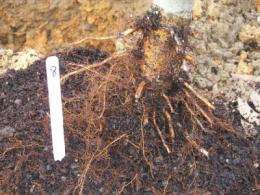Planting depth's effect on container-grown trees

Many landscape trees are started in-ground, then sold as bare-root ''liners'' to producers who plant them in large containers to grow. To minimize wind damage and to facilitate transport from potting areas to growing beds, the liners are often buried deeper than necessary. This deep planting of liners results in "finished" container plants with deep structural roots, important foundations of root systems responsible for trees' health and stability. Deep structural roots are thought to contribute to physiological stresses resulting from oxygen deprivation.
J. Roger Harris and Susan D. Day from Virginia Polytechnic Institute and State University reported on their study of planting depth on pin oak and littleleaf linden trees in HortScience. "Green industry professionals are concerned about the increased number of landscape trees showing abnormally deep structural roots", Harris said. "Yet, the consequences of deep planting in production containers or the consequences of any adjustments made to planting depth at the time of transplant on growth in the landscape have not been reported for many species."
Harris and Day planted container-grown liners of pin oak and littleleaf linden trees in 50-L containers with the first main lateral roots (structural roots) at substrate-surface grade or 10 cm or 20 cm below grade (deep planting). Trees were grown in the 50-L containers for two growing seasons and in a simulated landscape for three additional seasons after transplanting, either with the top of the container substrate at soil level or with some roots and substrate removed so the original structural roots were just below the soil surface (remediated).
The experiments showed that deep planting pin oak -- but not littleleaf linden -- slowed growth during container production, but this effect did not continue after transplanting. Remediation of the 20-cm-deep pin oaks slowed growth during all three post-transplant years. Littleleaf linden remediation slowed growth for the first season after transplanting to a simulated landscape for 10-cm-deep trees and for the first two seasons for 20-cm-deep trees.
Evaluation of pin oak root systems three years after transplanting revealed vigorous growth of non-deflected adventitious roots that had formed on the trunks of deep trees; these roots appeared to be developing into main structural roots. No adventitious roots were present on littleleaf linden. Instead, deflected roots grew and produced deformed root systems on the linden trees.
"Remediating these species so as to expose root flares and to remove circling roots at transplanting may be more critical to ensure future health and stability of the tree. Thus, the resulting slower post-transplant growth is probably a justifiable expense", Harris said. "Our observations of littleleaf linden root system conditions three years after transplanting from containers suggest that root ball alteration at planting -- such as shaving or slicing outside edges or the use of special root pruning containers—should also be considered."
Harris and Day said their research suggests that nursery practices that minimize deep planting of liners in containers should be used as a general practice, regardless of tree species.
More information: The complete study and abstract are available on the ASHS HortScience electronic journal web site: hortsci.ashspublications.org/c … /abstract/45/12/1793
Provided by American Society for Horticultural Science

















